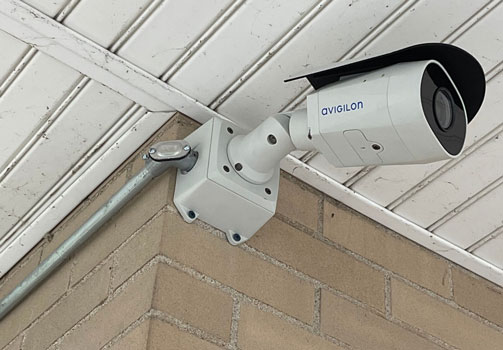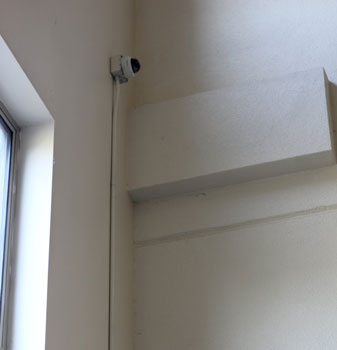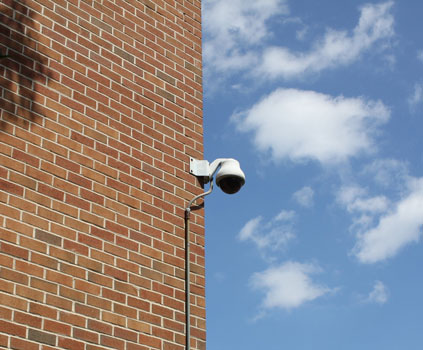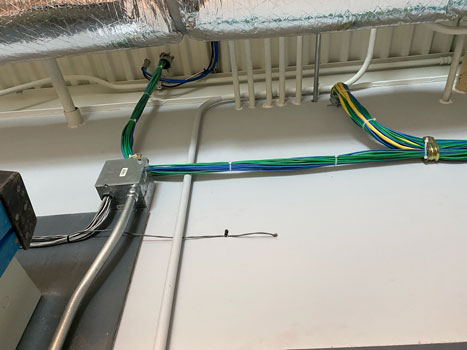Video MGMT System
 Access Control
Access Control
Voice & Data Wiring
 Burglar Alarm
Burglar Alarm
 Fire Alarm
Fire Alarm
Video MGMT System
Voice & Data Wiring
There are seven main types of security cameras: dome cameras, turret cameras, bullet cameras, multi-sensor cameras, fisheye cameras, pan-tilt-zoom cameras, and license plate recognition cameras. Each camera type is designed for particular image resolutions, viewing angles, depths of field, deterrence abilities, and specialized documentation aptitudes.

The core components of a security camera are its lens, image sensor, housing, mount, and software.
A camera lens captures light (photons) from its field of view and focuses that light on an image sensor.
A narrow lens can capture more detail in a smaller area than a wide-angle lens. This is because a narrow lens focuses on a smaller area to grab photons, whereas a wide-angle lens spreads its focus to capture photons over a larger area.
A lens's aperture determines how much light is allowed into the camera. Larger apertures are necessary for installations in low-light settings because they allow more light to enter. The lens aperture also affects the image exposure, with a larger aperture resulting in a brighter image.
Image sensors convert light photons captured by lenses into electrical signals.
The image sensor's resolution, sensitivity, and dynamic range capabilities all play a critical role in the final image quality. High-quality image sensors are necessary for installations with high contrast or color accuracy requirements.
A lens's focal length is the distance between the lens and the image sensor. A shorter focal length results in a wider angle of view, whereas a longer focal length provides a narrower view and higher magnification.

Many cameras include housings. For example, dome cameras often have smoked glass housings that disguise them or let them blend in with their environments.
Some cameras have specialized housings that are explosion-proof or suitable for underwater environments.

A camera's mount affects the ease with which it can be aimed after installation and the areas where it can be mounted.
For example, an outdoor dome camera should never be installed on its side because water is likely to accumulate between the housing and the mount. Ultimately, when water freezes, it causes the seal between a dome camera's mount and housing to crack.
Turret cameras don't share that vulnerability because they lack housings. They can be mounted on solid surfaces at any angle whether indoors or out.
What's more, their ball-and-socket mount design lets them rotate for easy repositioning after installation.
Pan-Tilt-Zoom (PTZ) cameras are the easiest camera type to reposition because their mounts have motorized gears, belts, and pulleys. The motorized mounts enable precise movements based on real-time user inputs and make PTZ cameras ideal for tracking moving subjects over wide areas.
A camera's software is its brain. For example, the software in a PTZ camera receives input from users via remote controls or other interfaces and then translates that input into commands for motorized movement.
Advanced software is at the core of license plate recognition (LPR) cameras. LPR software has been trained through deep learning algorithms to recognize and isolate digits from vehicle plates. Today's most cutting-edge cameras feature software with artificial intelligence capable of real-time video analysis. With the right software, a security camera can identify faces and recognize suspicious or unwanted behaviors.
Video data from security cameras is transmitted to the cloud or to local video recording devices like DVRs and NVRs for storage. While analog cameras use traditional DVRs for low-quality footage, the high-definition cameras installed by Mammoth Security store crystal-clear digital data on the cloud or on NVRs (Network Video Recorders).

Most commercial-grade security camera systems use cables for data transmission and to connect with power sources.
On the other hand, wireless security cameras transmit their data to cell towers or Wi-Fi routers as invisible radio frequency waves. These systems require less installation work than hardwired cameras, but they're avoided in most commercial applications because they're significantly less reliable.
Security cameras capture, process, and transmit light data from a monitored area to a monitoring device or recording system.
A security camera consists of a lens that captures light, an image sensor that converts that light into electrical signals, and processing software. The camera then transmits its video data to a receiver or recording device using either a wired network or wireless technology.
If you're ready to take the next step toward securing your property with commercial security cameras, fill out the simple form below to schedule a free site survey and consultation with a friendly security expert from our team.
NOT COMPLETELY SURE?
860-748-4292Security cameras connect to the Internet using either hardwired or wireless connections. Hardwiring with an ethernet cable is the most reliable method of connection.
On the other hand, a wireless security camera connects with the Internet by transmitting radio wave signals to a Wi-Fi router or a mobile network tower.
The length of time that commercial security cameras keep footage depends on factors like the system's storage capacity and the quality of the captured footage.
While most DVR and NVR systems overwrite old footage as needed to make room for new footage, some systems can be configured to retain video for specified periods, ranging from one day to three months.
The qualities to look for in a commercial security camera depend on the type of footage required and the environment where the camera will be installed. Each of the seven main types of security cameras is constructed with different lenses, image sensors, housings, mounts, and software components to capture different types of footage in different settings.
Surveillance and security cameras are both used for monitoring, and the terms are almost always used interchangeably. However, security cameras can refer specifically to cameras that protect properties like homes and businesses, whereas surveillance cameras can refer specifically to installations for broader observations of public spaces, like streets and transportation hubs.
Wired security cameras are better than wireless cameras because they're much more reliable.